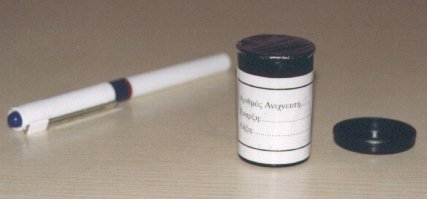UNIVERSITY OF IOANNINA

Radon investigations carried out by our Group extend to various fields of interest, including:
![]() Indoor Radon surveys
Indoor Radon surveys
![]() Outdoor Radon studies
Outdoor Radon studies
![]() Air Radon measurements
Air Radon measurements
![]() Radon studies in the laboratory
Radon studies in the laboratory
![]() Radon and earthquake prediction
Radon and earthquake prediction
Standardized plastic chambers of cylindrical geometry (2.5 cm in diameter by 5 cm tall) are routinely used for indoor radon measurements.
|
CR-39 detectors are cut in small pieces
(1.5 x 1.5 cm) and fixed at the bottom of the chamber. The top of the
chamber is covered with a polyethylene film to
prevent the entry of 220Rn and 219Rn isotopes
and protect the detector surface from dust particles. |
CR-39 chamber used for indoor radon measurements. |
Using the above arrangement, surveys have been conducted in different types of
houses in the region of Epirus (Northwestern Greece). Radon distributions in the
cellar, on the ground floor and the first floor of detached houses and in
apartments of multi-storey buildings have been assessed. In a sample of
approximately 100 dwellings, annual radon concentrations were found to
range from 55 to 90 Bq m3 in apartments and from 61 to 191 Bq m3 in
detached houses. The mean effective doses received by apartment and
detached house dwellers were 0.8 and 1.8 mSv y-1, respectively.
An extensive radon survey of indoor radon concentrations in dwellings located in
the town of Metsovo in north-western Greece, has been carried out. The indoor
radon concentration levels varied from 17.6 to 750.4 Bq m-3. Seasonal
variation of the radon levels and the influence of house features and soil have
also been pursued.
The CR-39 method has been used in field investigations, to study radon diffusion
in the soil and correlate with temperature, atmospheric pressure and soil humidity variations.
For such studies, the CR-39 detectors are fixed at the upper, closed end of PVC
tubes, which are placed in holes dug in the soil. The bottom end of the PVC
tubes is covered with a polyethylene film to exclude 220Rn, water
vapors or any contamination from the measuring arrangement. The CR-39 detectors
are thus exposed to the soil gas for typical periods of two to three weeks.
To measure radon concentrations in the air, air is forced through paper filters
using a high capacity pump (1 m3 min-1). The radon gas
escapes, but its progeny is retained on the filter, which is subsequently packed
in a standard petri geometry and measured by gamma-spectroscopy
using a HPGe detector. After analyzing the time evolution of the radon
daughters’ activity, radon concentrations are calculated by least-squares
fitting to the Bateman equations of radioactive decay.
With this method, radon concentrations in the air of the city of Ioannina were
found to range from 0.1 to 7 Bq m-3.
Radon studies in the laboratory
A special diffusion chamber, using a CAM-PIPS detector has been designed for radon studies in the laboratory. The chamber consists of two equal halves, upper and lower, while a small sample container can be air-tightly fixed in between. A 226Ra source is placed in the lower half and radon diffusing through the sample to the upper half is monitored by the CAM-PIPS detector.
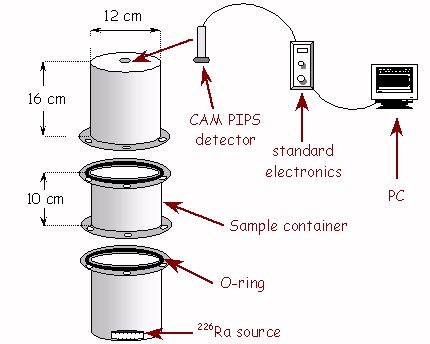
Chamber designed for radon measurements using the CAM-PIPS detector.
In a typical alpha-particle spectrum of the CAM-PIPS detector (see figure below),
the two peaks attributed to the polonium isotopes (218Po,
t1/2 =3.05 min and 214Po, t1/2 = 69
μs)
produced during radon decay are recorded.
A series of such spectra are acquired every 104 s for a 3 days period
and each one is analyzed for the 218Po peak. Since the particular isotope
is short lived compared to 222Rn (t1/2 = 3.82 d), the two radionuclides
reach an equilibrium state soon after the beginning of the measurement. Therefore, the
final 222Rn levels are predicted by fitting the Bateman equations of
radioactive decay to the experimental data of 218Po build-up.
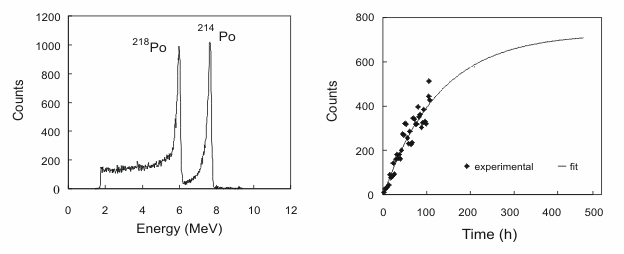
|
A typical spectrum acquired with the CAM-PIPS detector. |
Predicting radon concentration by fitting Bateman's equations to the experimental data. |
The above technique has been used for several investigations – i.e. to study radon diffusion through different types of soil columns, to examine the effect of soil humidity on radon diffusion, to investigate radon permeation through filters and membranes, to evaluate the effect of paint emulsions on radon emanation from surfaces
Radon and geological faults exploration
The distribution of radon in soil gas is considered to be a promising tool in
assessing geological profiles and tectonic discontinuities.
The profile of soil gas radon was monitored in five active fault sites in northern and
northwestern Greece. Measurements were carried out during summer months, using
CR-39 Solid State Nuclear Track Detectors (SSNTDs), which were placed along
lines traversing the fault zones. The spatial distribution of radon revealed
anomalies, clearly connected to the tectonic structure of the sites. An
illustration
of radon variations along the Almopia faults site (region of Macedonia, Greece)
is shown in the figure below.
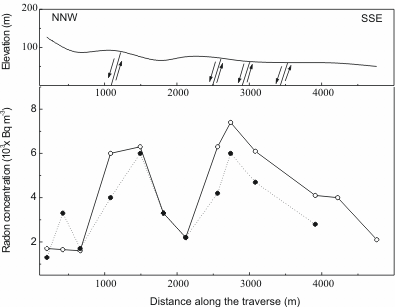
Geological transection showing the location of the faults along the Almopia site.
Radon profiles during two sampling periods are shown.
Radon and earthquake prediction
An ongoing study is carried out to correlate soil gas radon variations with seismic
activity. Since 2001, continuous field measurements are obtained
systematically in the region of Ioannina, by means of a BARASOL probe
buried 1 m below ground surface.
A striking radon anomaly was recorded as a pre-seismic phenomenon two days before the Lefkada
(Ionian Sea) earthquake (Mw 6.3) of August 14, 2003. A radon signal-to-background ratio of 103
was observed at the measuring station, 90 km NE from the main shock
epicenter.
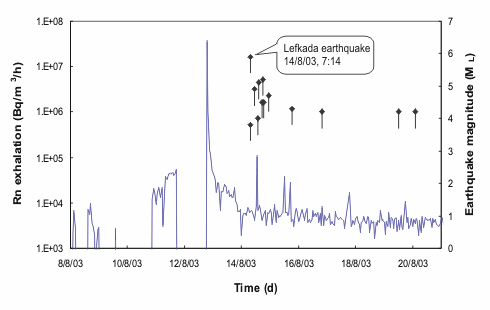
Radon anomalies, associated with the Lefkada earthquake.
| About Us | Instrumentation | Activities | Publications | Links |
